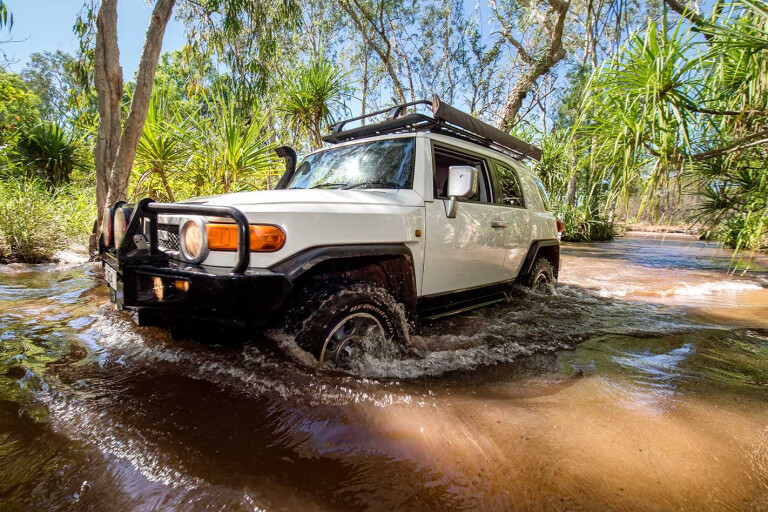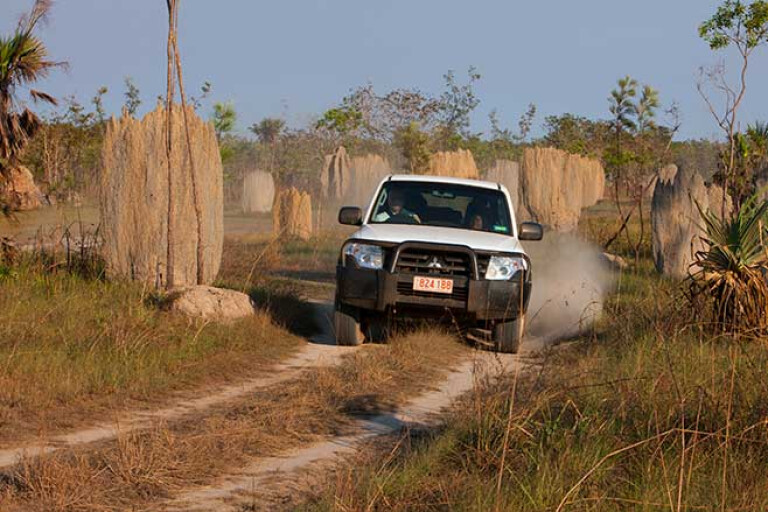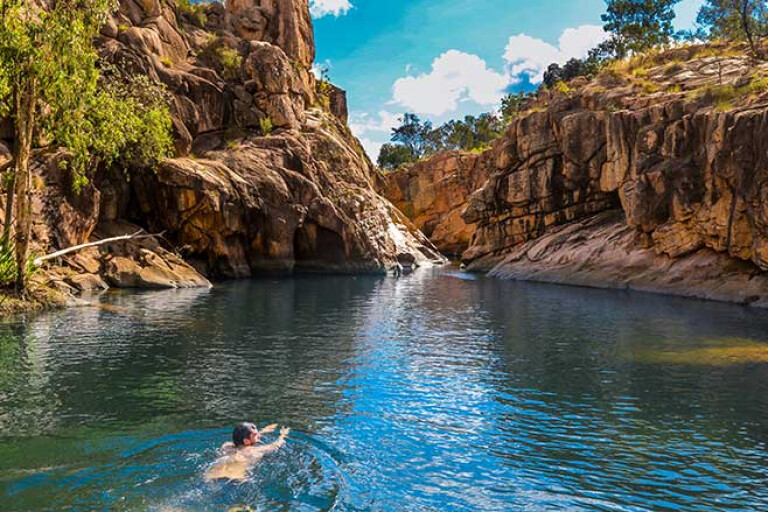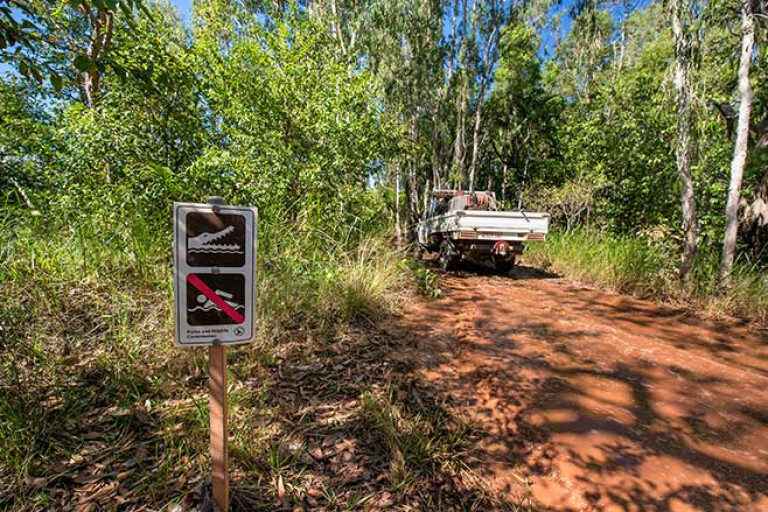
AS THE colder months take hold in the southern states of Australia, a lot of us are thinking of escaping to the warmer climes of the north.
At this stage, 2020 probably isn’t going to be a year for travel, but as you’re shivering in your Uggies this winter, start making plans to ensure some respite in the years ahead.
The Top End of the Northern Territory is a destination on the bucket list of most, if not all 4x4 travellers. Not only does it offer warmth all year ’round but there’s plenty of adventures to be had there, particularly if you’re keen to get off the beaten track.
Unfortunately for most of us, particularly those in the southern states, the Top End is a long way away and a 4x4 trip there usually means a week of travel either end of your adventures just to get there and back. It’s something many folks just can’t afford to spend that much time away from home and work.
FLY IN, FLY OUT
THERE IS A WAY to maximise your time in the Territory with a fly-in/fly-out holiday to Darwin and either hiring a 4x4 vehicle or joining one of the many 4x4 tours available. There are plenty of Darwin-based tour operators and companies that can rent you a 4x4 vehicle to explore.
We did just this and left mid-winter Melbourne for 30˚C-plus sunny days in the Top End. Direct flights to Darwin from most capital cities make this easy and with clever packing you can transport all you need for your off-road exploration and camping.

Darwin is unlike any other capital in Australia. It’s chilled vibe and friendly locals are a refreshing change from folks down south who are too rugged up behind scarves and hats to say g’day. It’s very much a tourist town with plenty of fully kitted 4x4s covered in red dust roaming the streets, and a variety of languages heard in the many bars and cafes.
There’s plenty to see and do in town, too, and we killed an afternoon at Crocosaurus Cove where we caught the croc-feeding show and swam with one of the bigger crocs in the protected tank. After managing to stay off the croc’s menu, we enjoyed a meal at the well-developed waterfront precinct but we were keen to get out of town to see the crocs in the wild.
You don’t need to venture far from Darwin to see crocs in their natural habitat. The world-renowned Kakadu and Litchfield National Parks are less than a half-a-days' drive from the city. We headed for Kakadu on a tour with Territory Expeditions, in one of its 4x4 trucks.
Before you reach the national park you come to the Mary River Wetlands, where there are numerous tour operators offering wildlife and croc experiences on the water. A cruise on Corroboree Billabong is an easy way to get out on the water, and it wasn’t long before we saw some big crocs gliding through the water and lazing on the banks. The eagle-eyed skipper was expert at getting us as close as possible to them and also spotting and identifying the plethora of water birds on the billabong.
KAKADU NATIONAL PARK
KAKADU NATIONAL PARK is just 250km from Darwin, so you can get out of the 4x4 and enjoy the sites before lunchtime if you leave town early enough. There’s plenty of Aboriginal culture and art to discover within the park, and the best way to find and appreciate it is to drop in to one of the information stations or take a guided tour.

The rock art site at Ubirr is a place where you can easily access and view the many different art sites via a relatively flat loop walk. Do it with one of the park guides for some local knowledge and interpretations of what the art means and signifies. One of the more interesting pieces of rock art depicts a thylacine, better known as the Tasmanian Tiger. Not known for being in these parts, the thylacine is thought to have become extinct on mainland Australia 2000 to 3000 years ago, before the last of them was lost in Tasmania back in the 1930s.
For the more energetic there’s a short but steep climb to the top of Ubirr Rock that offers spectacular views out across the floodplains below. With storm clouds approaching from one direction, fire and smoke rising in another, this hilltop was the perfect place to break from the group to experience in solitude the feeling and beauty of such a magical place and forget the cold city you left just a day earlier.
The drive to a campsite at Mardugal was perfectly timed to enjoy a quick sundowner at Yellow Water Lagoon (Ngurrungurrudjba). There are cruises available on the wetlands here, but the westward-facing view from the jetty is the perfect spot to catch a Territory sunset and reflect on the day.
WATERHOLES
AFTER SEEING MANY crocs in the waters around the floodplains it was with some trepidation that we ventured off toward Jim Jim Falls and the promise of a swim in the cool waters.
Many of the waterholes and waterfalls within Kakadu look inviting, but you have to assume there will be crocodiles in the water unless told otherwise by a reputable source such as a park ranger or tour guide. Most of the waterways within the park are signposted to indicate whether they are safe, and there are plenty of signs warning of crocodiles and where not to swim.
The drive in to Jim Jim is via the Karnamarr campground, the last 10km of it for 4x4 vehicles only, but it’s not difficult off road driving and anyone should be able to do it. From the carpark it’s a further walk to the falls, ensuring that by the time you reach the pool you are well and truly looking for a quick swim.
The waters are cool and refreshing, and depending if there is any sun on the pool at the time, dark. But a swim here is the perfect way to sooth the humidity of the day ... and the aches and pains from the walk.

While there were no crocodiles at the waterhole we were reminded they are not the only animals that can hurt or kill you in the Top End. While enjoying lunch back at Karnamarr, the park ranger showed up with a death adder he caught at his doorstep that morning. The death adder is one of the most venomous snakes in the world and, without proper treatment, a bite will kill you quickly. The ranger was going to release it a safe distance from the campground.
The waterhole and falls at Maguk, or Barramundi Gorge, are well worth the walk, too. The one kilometre, mainly flat, walk follows a creek before delivering you to a stunning large pool with the falls at the other end. A pleasant swim gets you across to the falls, which you can swim beneath. There’s a basic campground at Maguk and this is a spot where you could spend more time, but we had other waterfalls to find.
To cap off the afternoon, we went to one of the most photographed waterholes in the park. But to reach the iconic spot, you first need to complete a steep 450m climb up the escarpment. It's worth the effort. The pools atop Gunlom Falls run right to the edge of the cliff, forming a natural infinity pool where you can soak in the amazing view. It’s this unique and unmissable perspective that ensures images of Gunlon are plastered all over social media.

At the time of our visit in 2019, the track up the escarpment was being improved to make it more accessible, so this work should be completed by now. For those less energetic, there’s the plunge pool at the bottom of the falls, but it’s less spectacular.
The campsite at Gunlom is large and spacious and offers shower and toilet facilities for campers, caravans and camper trailers. It’s location makes it an ideal base for those looking to explore the walks and swimming holes in this southern part of the park. There are park and camping fees required to access and use Kakadu park, so research before you visit.
Our camp this night was just outside the park at the Mary River Roadhouse that offers a quality campground and facilities, plus the chance to enjoy a few cool drinks and a game of pool at the bar after dinner.
One last waterhole before ending the trip, this one a lesser-known small gorge not far from the Roadhouse. Ikoymarrwa, or Moline Rockhole, is a small gorge at the end of a 4x4 track at the southern edge of Kakadu National Park. It’s a short walk from the small carpark to the rock hole, where it’s possible to swim and sit under the falls when flowing. Due to its size and location, Moline Rockhole is one of the few within Kakadu that is open all year around, including in the wet season.
Moline provided a last taste of the water in Kakadu, and from the southern border of the park it’s around 160km on sealed road to the Stuart Highway at Pine Creek. From here you can turn south where its 95km to Katherine or north 225km back to Darwin.

Our three-day jaunt through Kakadu was only a small taste of what the park has to offer but enough to leave you wanting more. More importantly it provides a respite from the winter chill down south and a chance to plan more adventures in the Top End. We spent a few days in Katherine to make it a week away, and your time in the Top End is only limited by your ability to escape the every day.
At the time of going to print, Kakadu National Park, like most national parks in Australia, was closed due to quarantine regulations, but there’s nothing to stop you preparing your 2021 winter escape now.
ESSENTIAL INFO
KAKADU NATIONAL PARK
BEST TIME TO VISIT: The park is open all year; the dry season runs from April through to October and is the best time to see most of the park and surrounds.
WHERE IS IT? Kakadu NP is 250km east of Darwin and 150km north of Katherine.
GETTING AROUND: It’s best to have a 4x4 vehicle for exploring Kakadu and the Top End. Either bring your own or hire one in Darwin. If you don’t want to do it yourself join an organised tour, such as Territory Expeditions.
MORE INFORMATION
https://territoryexpeditions.com.au
https://northernterritory.com/kakadu-and-surrounds
https://www.crocosauruscove.com
https://parksaustralia.gov.au/kakadu



COMMENTS